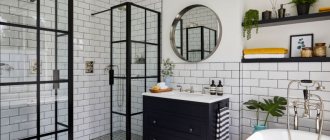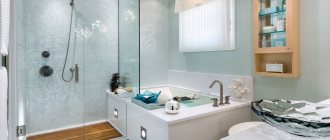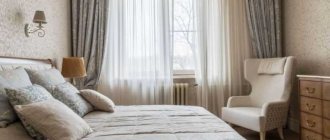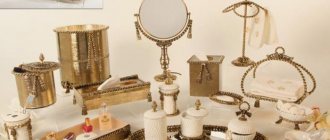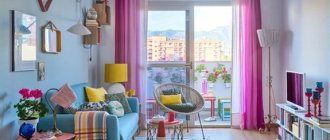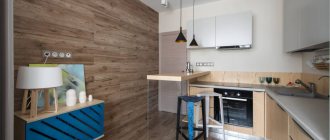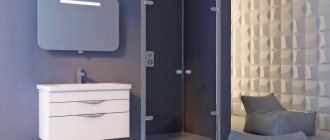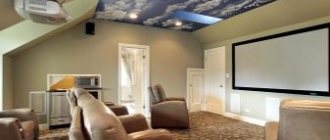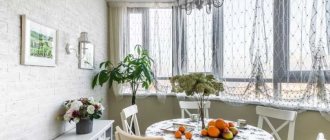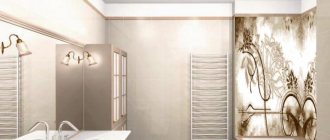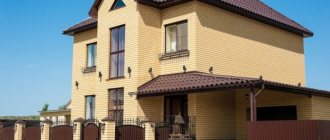Features of using paint in the bathroom
Using the painting method in bathroom design has a number of advantages:
- A wide range of colors allows you to create a unique interior.
- Unlike the labor-intensive and costly task of laying tiles, painting is a quick and inexpensive way to transform a space.
- High-quality modern products create a protective layer, preventing the appearance of fungus and mold.
- Compliance with the stages of painting walls is a guarantee of the durability of the created decorative coating.
Painted walls will help create a unique bathroom interior.
If necessary, you can paint already laid ceramic tiles.
The main thing is that the surfaces are properly prepared, cleaned, sanded and primed.
Which coating to choose
The choice of paints for a sanitary unit is huge. Each option has different advantages and disadvantages of use. Let's look at each type.
Water-based
It attracts with a number of positive properties: it does not contain toxic substances; dries quickly; allows vapor to pass through, so fungus does not develop on painted walls.
Typically, water-based coating is used for painting ceilings and walls in dry rooms. For example, in a nursery or living room.
However, it also has disadvantages. Before painting, you will have to carefully prepare the walls. In addition, it is easily washed off with water, so it is not advisable to use it in the bathroom.
Acrylic
This product is created on the basis of synthetic rubbers. After application, like water-based emulsion, it can be easily removed with water. But once the paint dries, it can only be removed with special solvents.
Dark gray bathroom decorated with acrylic coating
This product has several advantages: it dries very quickly, it has practically no unpleasant odor, so you should not be afraid of allergic reactions, and after drying it becomes one of the most moisture-resistant products. In terms of price and quality, acrylic is one of the best options for painting a bathroom.
If the room has a window that allows sunlight to enter, there is no need to worry about fading. Acrylic is not subject to fading in the sun.
It is especially worth noting the possibility of using this product for any type of surface. This property helps to minimize the time required to prepare the surface before painting. True, acrylic paints do not adhere to painted surfaces. The decorative layer of the old coating will have to be removed.
Latex
It is created on the basis of natural ingredients (rubber juice), is very easy to apply, dries quickly, does not have a strong chemical odor, and is abrasion resistant.
If the durability of the coating is important to you, you should pay attention to latex paint.
A room painted with latex paints retains its original appearance for a very long time. The low consumption and affordable cost of the material are also attractive.
Disadvantages of use:
- careful preparation is required before painting (a thin film of latex emphasizes even the most minor flaws);
- Latex paints are not suitable for painting in unheated rooms.
Oily
If you are ready for a long ordeal with a pungent odor, you can choose this type. Its advantages may outweigh the disadvantages if it is important for you to choose a product suitable for any coating, with a high waterproof rating, uniform application, and at the same time an affordable price.
Oil types allow you to get a deep shade of the walls, even if pastel colors are chosen
The richness of the paint will allow you to create a bright, contrasting design if you combine deep, bold flowers with snow-white fixtures.
Luscious bathroom interior with walls coated with oil paint
However, you should be prepared for the fact that the painted area will take a long time to dry, and the smell will persist for several weeks. It seems good if there is a window in the bathroom - you can get rid of odors with the help of ventilation. But here a new disadvantage emerges - under the influence of sunlight, the oil coating will fade, and in the future it will crack and crumble. Another renovation will be required.
And getting rid of even old, crumbling oil-based coating is not so easy. The video shows how to do this with a minimum of effort.
Glossy
This product is perfect if the room has smooth, smooth walls. Well, or you are ready to make them like that. If both times the answer is no, scroll through the list further. And that's why.
Any flaw in the original site will easily show through the thin coating, the shine of which will only emphasize the terrifying relief.
But perhaps it’s worth taking up plastering and still choosing this type, because it has a number of advantages:
- helps to visually expand the space of the bathroom due to its texture;
- has a high elasticity index;
- creates the effect of a mirror surface;
- painted areas are easy to maintain.
Chlorinated rubber
This product was specifically designed to transform bathrooms, swimming pools and even saunas.
This type will help make your bath not only beautiful, but also safe: it does not contain harmful impurities
Main advantages:
- withstands contact with water well, maintaining its original appearance;
- does not change color when exposed to ultraviolet radiation;
- does not contain toxic substances.
The main disadvantage of chlorinated rubber is the high cost of the material. The repair budget will have to be drawn up in advance.
You should also be prepared for the fact that painting requires careful preliminary preparation of rough surfaces.
Alkyd
It is resistant to abrasion (it is often used for painting building facades). Walls painted with alkyd paint can be washed using chemicals.
The painted surface retains its original appearance for a long time.
It is also worth noting the following positive aspects of using alkyd paint:
- Possibility of painting at any temperature;
- affordable price;
- quick drying.
There are two disadvantages of using it. First of all, it has a very strong smell. So it is better to use the material only in a well-ventilated room. Secondly, the paint does not allow steam to pass through.
In the absence of ventilation and additional protection, fungus and mold appear on the painted surface over time.
Silicone
Belongs to the category of water-based compositions. It is distinguished by its absence of odor and good adhesion to the surface being painted.
One of the advantages of the silicone type is resistance to sunlight.
There are several advantages. Firstly, the paint does not require pre-treatment of the rough wall. Secondly, it retains its color when exposed to sunlight.
Due to the fact that the layer of silicone paint allows vapor to pass through, fungi do not grow on the painted surface.
The main disadvantage of this material is its high cost.
Material selection
Regulatory features
Painting bathroom walls is completed perfectly when the intermediate steps are completed flawlessly. The first priority is the selection of paint. Key Features:
- Appearance: color, degree of gloss (gloss).
Domestic standards. - Adhesion, which determines the adhesive force that prevents peeling.
Determination of adhesion. - Resistance to water, detergents, temperature, light.
- Strength, hardness, elasticity, providing resistance to abrasion, impact, and deformation.
- Vapor permeability. Expressed as the mass of vapor passing through the surface during time, or the equivalent thickness of air (Sd). Bathroom spacing Sd = 0.05 – 0.25 m.
- Water permeability is characterized by the water absorption coefficient (W), the optimal value for a bathroom is W<0.1.
Water absorption - Technological indicators: viscosity, hiding power, consumption, drying time, shelf life, solubility.
- Hygiene combines chemical safety, antibacterial properties, and care requirements.
- Durability.
Technical specifications for enamels, water-dispersion paints: GOST R 51691-2000, GOST 28196-89.
Oil will not damage the wall
The Soviet standard oil painting of a half-height bathroom was explained by economy and poor vapor permeability: whitewashing allowed the panels to “breathe.” Oil compositions are not relevant for baths:
- Promote the “sauna” effect.
- They take a long time to dry, releasing an unpleasant “aroma”.
- Toxic.
- Fire hazardous.
Previously, thickly ground mixtures were produced, the shades varied by the concentration of the dye. Modern ready-to-use palettes are much poorer than water-based ones.
The interior of a communal bathroom, the panels are half painted.
"Bath in oil."
Hardness and water resistance are improved by increasing the drying temperature. Often the oil coating adheres very firmly to the wall. Special primers make it possible to dispense with repairs by notching the old layer for better penetration. However, serious damage to the walls can be “treated” by complete removal.
Special soil
Advanced fungal “gangrene”, complicated by peeling of the plaster.
Oil is a budget saving solution for a hostel or an old rented apartment. A satisfactorily preserved layer of the same type can be painted on top, renewing it for a couple of years.
Universal alkyd
Alkyd enamels are an option not without disadvantages:
- Harmful fumes in a closed space can easily cause poisoning. The persistent smell lasts for weeks.
- It is difficult to paint without drips; too much solvent takes away the gloss. Surface irregularities are clearly visible.
- Despite the waterproof film, the enamel can peel off due to poor adhesion to the putty. Mediocre elasticity leads to corner cracks.
- Condensation is a constant companion to the continuous painting of the bathroom; effective ventilation offers hope of eliminating this.
The walls in the bathroom will have to be prepared for painting. The benefit in terms of money is small, glossy shine is a matter of taste. Stylish interior design and pentaphthalic paints are difficult to combine.
The splash-prone PF-115 fell away.
Strengths of the group:
- Excellent abrasion resistance.
- Wide operating temperature range: -50 – +60˚C.
- Resistant to direct sunlight, alkalis, oils. Causes long-term preservation of shine, brightness, color saturation.
- Withstands shower jets.
- Painted panels can be easily cleaned with a sponge and detergent.
- Thickened enamels are dissolved to their original state with white spirit.
Design without pretensions.
Pentaphthalic or glyphthalic alkyd varnish is a base substance, the shade is determined by pigments, special properties are determined by fillers, additives, for example, antiseptic.
The iconic Russian representative is PF-115. Choose one manufactured according to GOST 6465-76. Marketing gimmicks: factory specifications, original brands (PF-116), promising names (“Extra”, “Super”, “Yacht”) - do not mean premium quality.
Let's repaint the shower room anew
Water emulsion is a popular means of updating shower panels with your own, albeit inexperienced, hands. They also decorate baseboards and furniture, although the durability is inferior to varnish or ceramics.
There are water-emulsion and water-dispersion compositions. The first represent aqueous emulsions of polymers, that is, a liquid phase in a liquid medium. The second are suspensions - suspensions of tiny solid particles, evenly distributed throughout the volume of liquid. In everyday life, concepts are combined.
The mixtures do not contain solvents other than water, therefore they are harmless and odorless. After drying, they are resistant to washing, mechanical wear, and light. They have good vapor permeability. Specific ingredients reduce wettability, promoting droplet rolling.
Usually supplied untinted - white. By adding the appropriate dye, the desired shade is obtained. Professionals use tinting machines that provide consistent repeatability. The databases contain up to 20,000 variations. It is difficult to choose a shade identical to an existing one on your own.
In the old fashioned way, aqueous emulsion is a name given to a budget polyvinyl acetate dispersion, which is unsuitable due to its low water resistance.
Among the water-based products, the operating conditions of the shower meet:
- Acrylic, consisting of acrylic film-forming substances, fillers, pigments, special additives, H2O.
Halo
They are distinguished by high adhesion to various substrates, stability to ultraviolet radiation, and fill hair fibers up to 0.5 mm. Atmospheric, facade, washing - waterproof modifications containing the highest percentage of acrylic, which forms a protective film. Consumption rate 130 – 150 g/m² single-layer coating. - Latex ones contain polyacrylic dispersion, synthetic latex, and other ingredients are similar. More elastic, mask defects and cracks up to 2 mm wide. Consumption: 140 – 180 g/m². A quarter more expensive than the previous ones.
Tikkurila Euro 20 - Silicone varieties are optimized for outdoor use and withstand precipitation. The functions are provided by polysiloxane resin. Shows better results, expensive solution.
Derufa
Buy products with the specified area: “for wet rooms”, “for bathrooms”. Clarifications: “washable”, “wash-resistant” do not guarantee the required level of water resistance. Facade, weather-resistant modifications are allowed if the instructions include the following clarification: “for external and internal work.” Consider the effect of larger filler on the texture.
Common mineral façade paints are conditionally suitable for bathrooms. In particular, two-component silicate, dispersion-silicate on liquid potassium glass. Liquid glass increases vapor permeability and absorption. Service life up to 20 years. Technological nuances create difficulties for inexperienced people.
The characteristics of water-dispersion paints are presented in the tables:
Technology
The first painting rule is: high-quality painting requires careful surface preparation. Leading manufacturers of finishing and paint materials offer systems: putty – primer – paint, each component is optimally selected.
The Luya waterproof system from Tikkurila includes: leveling with Presto LV putty, waterproofing with Luya primer, painting with the same product. Guaranteed service life is about 10 years.
Details: https://www.tikkurila.ru/dlya_vashego_doma/produkty/interernye_kraski/vannye_komnaty.
It is rational to create a three-component scheme by brands of one company in order to avoid compatibility problems. For example, a similar opportunity is provided by the following lines: “Empils”, “Belinka”, “Derufa”.
Stripping
Preparing any walls for new painting requires removing:
- Existing coverage.
- Loose, cracked, crumbling putty, plaster, mold.
The volume of procedures depends on the condition of the protective layer and base. If the paint holds tightly, it is enough to eliminate local defects. When the enamel falls off along with the sublayer, all suspicious areas are cleaned down to the root wall. In some cases, it is necessary to completely remove the finish and re-level it: putty or plaster.
Old enamel is considered suitable if, when scraped with a spatula, it is scratched without tearing off the layers. There should be no stuck fragments on the glued tape after tearing it off.
Overview of methods:
Manual
Manually clean with scrapers, metal brushes, rasps; files sharpened like a scraper, axes. The method is low-productive, seven sweats will do until you handle a large area. They manually process junctions and hard-to-reach areas behind pipes and plumbing fixtures. Advantages: accuracy, low noise.
Steel brush
The oil enamel is first scratched down to the underlayer, the area is generously moistened, allowed to soak in, and scraped. Success is determined by the type of plaster.
It is recommended to prime the water-based coating, let it sit for 5 - 10 minutes, and peel it off with a brush:
PVA emulsion can be easily removed:
- scratch the surface;
- apply a soap solution based on washing powder with a roller;
- wait 15 minutes;
- wash off the softened layer with a cloth rinsed in water.
Mechanized
Cleaning is done with a drill or grinder equipped with a wire attachment. The drill's performance is low. The “grinder” generates a lot of dust and leaves blemishes, because the nozzle is designed to remove rust.
Angle grinder cup attachment.
Wires pulled out at speed pose a significant danger. Work in overalls, tight-fitting goggles, and a respirator. A casing on an angle grinder is required.
The best results are demonstrated by flap abrasive wheels and cup diamond discs. It is advisable to modify the casing for dust removal with a vacuum cleaner.
Cleaning an angle grinder with a diamond disc:
Manufacturing of the casing:
Using a hammer drill can end in disaster: the sand-cement mortar will crumble along with the coating. The hammer drill does a good job with putty concrete. The noise level exceeds the permissible SanPiN.
Thermomechanical
Heated oil and alkyd enamel softens and is easier to remove with a spatula. The partition is heated with blowtorches, gas burners, and electric hair dryers. They act quickly, preventing the film from cooling.
Simultaneous heating with a hairdryer and cleaning with a spatula.
Chemical
Pentaphthalic, oil-based enamels react with solvents, the film decomposes. Ten-year-old layers are processed several times, removing layer by layer. To avoid mistakes, follow the instructions. Rubber gloves and a respirator are necessary protective attributes.
Disadvantages: significant consumption of expensive reagents, aggressive chemicals, possible unpleasant odor. After treatment with a remover, partitions need to be degreased, otherwise fresh putty and paint will bubble.
Eco-friendly water-borne remover.
Primer, putty
The purpose of the primer is to penetrate the structure, strengthen the base, average absorbency, and reduce paint consumption. Usually contains antifungal elements, otherwise additional impregnation is required.
We will leave the inscriptions on the containers “deep penetration soil” to marketers. No concentrate will “pierce” a two-centimeter thickness of plaster; you will have to rely on the initial adhesion to the brick.
Technical data of famous brands.
Component of the Euro series from Tikkurila.
The typical penetration depth into concrete and brick is 1 - 2 mm, cement-lime mortar is impregnated to 5 - 7 mm. Concentrates are diluted with water, the proportions vary by brand: 1:1 – 1:3. Water is added to the primer, and not vice versa.
A clean, dry base is primed with a brush, roller, or spray gun. Porous, hygroscopic structures are treated twice. Heavily coated - primed without diluting. To avoid dusting, reduce the time between complete drying and painting.
Inventory, consumables.
Cover the floor with cardboard.
Cover the facing with film.
Filling the tray.
If necessary, the panels are leveled with putty, for example, acrylate Euro Filler for Tikkurila systems. In other cases, they choose one that is related in chemical composition. Putty after the soil has dried.
Before installation, painted surfaces are washed, sanded to a matte state, and primed. Apply putty up to 5 mm thick. The next layer is applied after the previous one has dried. The dried one is sanded and primed again.
Painting
Let us illustrate the procedure for popular water-dispersion painting step by step:
We measure the temperature of the partitions.
We check the strength of the pile and reject the tool that does not pass the test.
We protect the corners with masking tape.
We paint corners and pipe outlets with a strip 6–10 cm wide.
We wet it with water and squeeze out the new coat.
Rolling out
We paint from top to bottom in stripes up to 1 m.
We perform cross passes.
Align from bottom to top.
We paint the entire plane from corner to corner in one go without stopping.
Apply the second layer after a couple of hours, taking into account the instructions and humidity.
We wash the instrument
Note: online calculators EMPILS, Tikkurila can be used for rough calculations of required paint materials from other companies.
Pro Tips:
How to paint bathroom walls at home
You can paint the walls in the bathroom quickly and efficiently if you follow a clear algorithm of actions:
1. Clean the rough surface from old decorative coating and loose plaster.
First you need to get rid of the previous coating.
2. Irregularities on the wall are puttied. The more carefully the stage is implemented, the better the repair result will look.
Puttying the walls ensures uniform paint application
3. After the putty has dried, the walls are sanded and coated with a primer.
Whatever material you choose, it is better to choose a primer with antibacterial properties.
4. Paint the walls. You should start from corners and hard-to-reach places. Here you can use a brush. But the open plane of the wall is painted using a roller.
Using a roller, the material is applied more evenly
Please note: to obtain a dense layer of color, the coating is applied twice. The second layer is applied to the painted surface only after the first has dried.
Decorative painting
You can give in to the creativity playing in the shower and try to paint the bathroom walls in an original way.
Stripes and other shapes
To depict geometric patterns, use masking tape. It is easy to apply and also easy to remove after finishing work.
The tape is pasted where they want to get a pattern and even borders. Thanks to this technique, the walls cease to be monotonous and monotonous. The tape is removed after the applied layer of paint has dried.
Stencils and drawings
Applying a design using a stencil is easy and interesting. You will need a ready-made stencil and a painting tool.
This is what it looks like in the photo:
Pattern rollers
The most pleasant way to work: ready-made rollers are sold, with patterns already applied to them. Dip the roller in paint, remove the excess and run it over the wall.
More ways to decorate walls:
Painting tiles in the bathroom
If the bathroom is tiled, it can also be painted. But what type of paint to choose for finishing work in such conditions? As a rule, in home repair work, the choice is a waterproof product with a high wear resistance. Epoxy-based oil types are best suited.
Painting tiles is an affordable and time-efficient way to update your bathroom
Then the old tiles are cleaned, paying special attention to the seams, and degreased. It is also sanded and coated with a primer. The sequence of work is clearly shown in this video.
By the way, here, unlike painting walls, only a foam roller can be used as a means of applying paint. The brush will leave streaks, no matter what color you choose.
How to prepare walls for painting
If, before applying paint, the wall is not cleared of the previous finishing material, then you need to resort to the following actions:
- potholes and deep cracks can be smoothed out with thick sandpaper;
- It is recommended to first level the plaster, cover the cracks with a new layer and rub out the remaining imperfections using sandpaper;
- Whitewash can be washed off with plenty of water, using a sponge;
- mold and fungal spores are removed using special solutions in accordance with the instructions.
Bathroom and shower Source remoo.ru
In beige color Source krovati-i-divany.ru
The old layer of paint can be removed in several ways. For a relatively recently applied layer, you will need a spatula or an angle grinder disc, or a chisel will also work. If the layer is dense enough, then it can be heated with a hair dryer, and then the peeled parts can be removed.
If paint is applied to already finished walls, then the tiles or plastic tiles must first be degreased.
Sea green bathroom Source dekor.delfi.ee
Examples of beautiful bathroom designs with painted walls
By choosing high-quality materials and following all stages of painting, you can not only update the interior of the room, but also create a beautiful design in the shortest possible time and for little money.
A painted wall can become a color accent in the design of a room.
A combination of pastel shades with white and gray will help create a delicate design.
Orange color will give you a boost of energy in the morning
A bathroom in shades of purple and lavender will calm you down and help you relax after a working day.
Decorating with painted walls will help you create a unique design that matches your ideas about a comfortable room.
